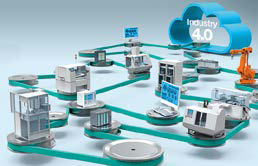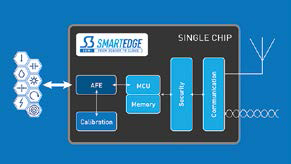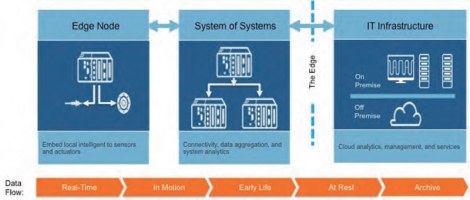Smart manufacturing and Industrial Internet of Things (IIoT) technologies are improving autonomous decision making in industrial operations. By offering a holistic view of shop operations in real time, these data-driven frameworks improve processes and support the implementation of continuous improvement strategies. To achieve the necessary level of transparency and data availability at the local level, companies need to embed edge computing systems into their frameworks.
Smart manufacturing practices leverage Big Data to perform descriptive, diagnostic, predictive, and prescriptive analytics that can provide clear insight into shop operations. The actionable insights gained from these processes support the deployment of IIoT applications that provide greater flexibility and responsiveness. Consequently, companies can optimize all aspects of manufacturing and ultimately improve their competitive advantage.
For example, companies can determine the optimal processing conditions needed to produce consistently high-quality products in real time. They can also predict when equipment will need maintenance or overhaul, and adjust its performance to support just-in-time manufacturing practices.
It's all about convergence
Turning factory data into knowledge to support next-level manufacturing requires technologies that can quickly interpret the information and share it with different parts of an organization. To achieve this, these systems must cross the boundaries that conventionally divide operational technology (OT) and information technology (IT) to support data availability across the enterprise.
Enterprise Edge devices are ideal candidates for this task, as they connect IT and OT while taking into account their different capabilities. For example, the OT world works with process speeds of milliseconds or less; instead, the IT world works with much longer sampling times, such as minutes, hours or more. The definition of reliability and cybersecurity for each domain also differs. In IT networks, this encompasses the provenance and security of data and devices, while in OT it is associated with the resiliency of systems.
Enterprise Edge solutions can act as a mediator, improving the performance of both worlds. They bring enterprise-grade infrastructure and modern IT concepts to the plant floor, while delivering the high performance of real-time responses and low latency typical of OT for higher-level management functions. In this way, they can connect the different "islands of automation" that often characterize existing manufacturing facilities.
What's in it for IT and OT
Enterprise Edge devices collect, aggregate, analyze, and share the ever-increasing volume of machine-level data streams from controllers on the shop floor. As a result, they can provide immediate information for fully automated decision making in real time.
Ultimately, companies can extract additional data from machines and plants with minimal effort to optimize and improve operations. This occurs without affecting the performance of production systems and manufacturing processes, as they can continue to function without being affected.
IT's advanced features for OT are beneficial for any application, but can become a lifesaver for facilities where XNUMX/XNUMX connectivity may not be a possibility. In these situations, the Edge can perform cloud-native functions to support the continuity of effective operations. Similarly, for industries where data residency and compliance are critical, such as the pharmaceutical sector, Enterprise Edge solutions are key to pre-processing sensitive data locally, while sharing data that is secure. to transfer them to larger enterprise-grade networks.
In addition to enhancing OT activities, Enterprise Edge systems also bring key benefits to the world of IT. They can perform data cleansing and pre-processing activities, unlocking the most advanced analytics potential in the cloud with reduced costs for bandwidth and storage. At the same time, edge devices can help facilitate the identification of key patterns within data and support the processing of segmented data, making sifting through pieces of information easier and faster.
In addition, the infrastructure offered by Enterprise Edge devices comes with cybersecurity benefits. Since the computation occurs closer to the data source, there is less data at risk at any one time. Also, because processing and storage functions are spread across the edge, the entire network is less susceptible to a single attack.
Data mining activities can also be enhanced using Enterprise Edge computing solutions. An advanced device incorporating the latest technologies can unleash the power of artificial intelligence (AI) to perform sophisticated data analysis and create actionable insights for predictive maintenance. For example, AI algorithms can identify wear patterns or detect anomalies long before actual equipment failure occurs. As a result, it is possible to create highly accurate maintenance schedules that minimize downtime and emergency shutdowns.
Develop highly efficient infrastructures
By leveraging the right Enterprise Edge solution, businesses can also benefit from a key tool for optimizing their networks. This can be used to achieve improvements in efficiency and bandwidth utilization, as large volumes of data are processed locally while only key data sets are transferred over the communications network. Similarly, the decentralized structure offered by the Edge can help enterprises adapt as well as expand their computing capabilities and infrastructures in a cost-effective manner and over time, without adding any additional bandwidth requirements.
Finally, by implementing an Enterprise Edge device that uses open communication technologies, such as CC-Link IE TSN, it is possible to connect and support a wide range of automation devices. This means that businesses can benefit from a solution that can support their intended applications without additional network considerations.
Technology with Edge
A proven Enterprise Edge solution used by manufacturers across multiple industries is Mitsubishi Electric's MELIPC series of industrial computers. It supports extensive connectivity to the plant level by offering compatibility with all major open networks. In addition, MELIPC's use of open technologies means that the device can be interfaced with machines or plant assets controlled by different automation vendors.
When it receives data, the Edge computing solution has a real-time data recording and processing environment. It incorporates a suite of analytical tools, such as multiple regression analysis, the Mahalanobis-Taguchi System (MTS) for diagnosis and forecasting through multivariate data, statistical process control (SPC), and AI capabilities.
MELIPC offers users the flexibility to integrate third-party applications into its dual operating system, which uses Windows and VxWorks RTOS. The VxWorks RTOS environment has a proven track record of running critical embedded applications where high availability is a mandatory requirement. Finally, the internal structure of MELIPC follows the principles of the Edgecross Consortium. It is an independent organization with more than 200 members, including NEC, Oracle and IBM, whose goal is to create an open edge computing software platform that provides a universal interface between industrial networks and IT functions. Edge.
The benefits of MELIPC have already been seen in a wide range of industries including food and beverage, automotive and packaging, and the technology has helped reduce downtime and increase quality, efficiency and reliability. product availability. Thanks to its advanced Edge computing capabilities, MELIPC has helped companies carry out their digital transformations and improve their competitiveness.








